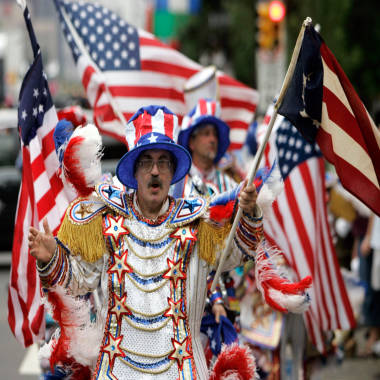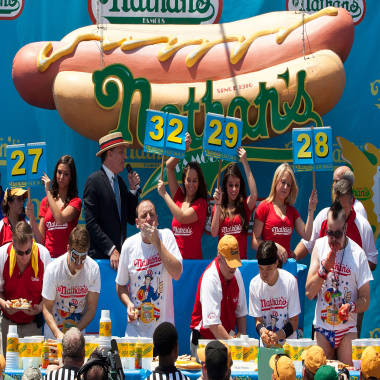Fireworks, parades, and cookouts, not to mention red, white and blue: The things Americans today most closely associate with the Fourth of July have been surprisingly constant since the country’s founding in 1776.
But how Americans have celebrated the Founding Fathers' breakup with King George III hasn't always been static, and the choices citizens have made over 237 years offer and indication of where the country has stood socially, politically and culturally.
“It is a barometer of changing American life,” said Matthew Dennis, author of the book “Red, White and Blue Letter Days: An American Calendar.”
Here's a look at how Fourth of July traditions have changed along with the country.
The date
There's not usually much room for debate when it comes to birthdays, but in America’s case, it's not clear cut.
Days after the Declaration of Independence was signed, founding father John Adams wrote: "The second day of July 1776 will be the most memorable epocha in the history of America. I am apt to believe that it will be celebrated by succeeding generations as the great anniversary festival," James Heintze noted in his book “The Fourth of July Encyclopedia.”
While Adams had the foresight to see that the country would mark America's independence with extraordinary celebrations, he was off on the timetable. The Continental Congress voted for independence on July 2, 1776, but it was two days later -- on July 4 -- that paper copies were printed and distributed to the states for ratification. Because the editions dated July 4 were most widely distributed, the date was adopted.
"The Declaration of Independence was meant to be read out loud and so it makes sense to celebrate when we spread the word of independence rather than when congressman in knee breeches voted on it,” said Benjamin Carp, a history professor at Tufts University in Boston and author of "Defiance of the Patriots" and "Rebels Rising."
Still, it took until 1941 for Congress to declare the date a national holiday.
The parades

Matt Rourke / AP
Rich Martinoand other Mummers parade during an Independence Day celebration in Philadelphia, Wednesday, July 4, 2007.
Today, parades offer a few hours to revel in balloons, floats, marching bands and general cheesiness. During the American Revolution they were about loyalty.
Not everyone in the colonies was on board with independence, according to Heintze. Some did not think the timing was right for such a proclamation, and others were simply content being an extension of the British Empire.
“It was a way to tell everyone, ‘I’m not a Torie,’ I’m out celebrating our independence,” said Heintze.
The spirit
These days the holiday is largely seen as a day to put aside politics and celebrate what unites Americans.
Not so in the beginning.
By the late eighteenth century Federalists and Anti-Federalists were battling for ownership of the celebration, a rivalry that at times turned deadly.
"The Fourth of July is a day to finally celebrate the articulation of the country's principles," said Dennis. "And when (people feel that) some of those principles are not being realized, the day has become a chance to emphasize it."
On July 4, 1788, a group of about 50 Anti-Federalists burned a copy of the Constitution while marching in Albany, New York, according to an account in "The Fourth of July Encyclopedia." They came across a group of Federalists and a battle/FIGHT took place that injured 18 people and killed one.
In the 1820s through the Civil War, abolitionists used the day to voice their dissent with slavery, according to the "Encyclopedia." And while whites in the South had little interest in celebrating the day following Confederate Gen. Robert E. Lee’s Civil War, African Americans continued “freedom celebrations” that helped ensure Independence Day’s significance didn't wane.
“As a celebration of the birth of a nation, yes some groups made use of the day for their own purposes, but the idea of the Fourth of July has really always been to commemorate the birth of a nation,” said Carp.
The fireworks
In John Adams' ill-fated prediction about the significance of July 2, he said America's birthday should be marked by "games, sports, guns, bells, bonfires and illuminations from one end of this continent to the other."
And the holiday has always been celebrated with bright lights, big bangs and fire. Artillery salutes using cannons and explosives left over from wars were the preferred method of American celebration in the country's earliest days, Heintz notes in the "Encyclopedia."
This year, 14,000 fireworks displays will take place around the Fourth of July, according to the American Pyrotechnics Association. APA Executive Director Julie Heckman calls the day the "bread and butter for the industry."
Heckman estimates that nearly 90 percent of consumer fireworka revenue and about 75 percent of professional display revenue comes from Independence Day sales. "I don't think the industry would have survived without the Fourth of July," she said. "Without the Fourth of July people wouldn't want to buy consumer fireworks."
Food and drink
The Fourth has always involved excess.
Gen. George Washington allotted double rations of rum to his soldiers during the Independence Day celebrations that took place during the American Revolution, Heintze notes.
Even though the fate of the nation hung in the balance, early Americans did not let worry dampen their spirits. Celebrations were often accompanied by plenty of food and booze.
Parades and public readings of the Declaration of Independence were traditionally followed by large town-wide feasts in the late 18th and early 19th centuries.
Celebrations today are generally confined more to private back yard barbecues, but excess is still on display.

Andrew Burton / Getty Images
NEW YORK, NY - JULY 04: Competitive eaters compete in the men's division of the Nathan's Famous International Hot Dog Eating Contest at Coney Island on July 4, 2012 in the Brooklyn borough of New York City. Joey Chestnut won the men's division by successfully tying his own world record by eating 68 hot dogs in 10 minutes; he has now won the competition six years in a row.
A prime example: Nathan’s Famous Fourth of July International Hot Dog-Eating Contest. Each year, contestants from around the world head to New York’s Coney Island to find out who can scarf down the most dogs in ten minutes.
Joey Chestnut of San Jose, Calif. holds the world record for chowing 68 hotdogs in 2009. If he takes the title again this year, he'll set another record, becoming the first person to win seventh Nathan's hot dog eating titles in a row.
By Andrew Rafferty, Staff Writer, NBC News
